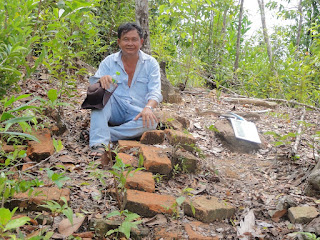14 March 2011
location:
n8.8895
e98.2949
n8.8895
e98.2949
 |
| The map, showing immediate surrounds. |
 |
| Our boat, no, the small boat. |
Google maps link to my detailed map of the site: http://goo.gl/maps/Lych
 |
| View of hilltop from centre of the river. |
 |
| View of Takuapa River mouth from hill top. |
 |
| whoossh, and away. |
The hilltop can be seen from across the bay. Visually, it is backstopped by a higher, darker coloured mountain behind, enhancing its visibility.
For myself, to reach this spot involved much discussion and planning. Apparently, there is no road route to the hill. With the help of the Fine Arts Dept. book Thung Tuk, I managed to explain to my tuk tuk driver where I wanted to go, who then decided to talk to his tuk tuk mates, and then a number of other locals, in order to put my journey together (this was an official Lost in Translation moment).
We finally determined that we would travel to a village on a river tributary, and from there take a small boat, approximately 2kms to the hill itself. On the drive to the boat we picked up a man who was the local village headman, a Mr Kamon (as his name transliterated into English), who had been seconded to aid me in my search for the site. As he spoke no English, and my tuk tuik driver knew only basic English, we never really discussed anything of note, however, he got me to the hill top and back.
We finally determined that we would travel to a village on a river tributary, and from there take a small boat, approximately 2kms to the hill itself. On the drive to the boat we picked up a man who was the local village headman, a Mr Kamon (as his name transliterated into English), who had been seconded to aid me in my search for the site. As he spoke no English, and my tuk tuik driver knew only basic English, we never really discussed anything of note, however, he got me to the hill top and back.
 |
| The hill. Note the distinctive tree atop. Easy to spot from the river |
I will say that the view along the river was superb. The water, the green things growing on the side of the river, the blue sky (a somewhat rare near cloudless day). Of course there was the small draw back of the very loud boat motor, which I clocked in the high 80s decibels. The journey out was smooth water, very pleasant, but coming back we experienced some chop.
 |
| out landing site. |
The landing site was at the end of a narrow canal inland, at a very small beach. We disembarked (not quiet as easy as it sounds). Then the Mr Kamon and myself began walking (our boat driver stayed with his boat) towards the hill. At first we walked over level ground, the hill itself is set back maybe 250m from the shore. Then we reached the hill.
The climb to the top was not too difficult, but it was tricky, steep in places. Just take it slow and easy, watch out for the spiky plants, and crumbly soil (much of the soil on the western facing side of the hill was crumbly). Let me add though, it was a hike. The day was hot (no cloud), it was humid (the tropics), the air was damp (tropical jungle), and add the previously things listed. It all added up.
 |
| My guide, Mr Kamon, the village headman. |
When we reached the top of the hill, ~15 minutes, we saw a central, flat area, with, what looked to me to be, a brick path running northward down the hill. This path was the major and essentially the only man made item on the hill top. There had been a statue of Vishnu present, but it had been removed in 1927 to Bangkok. I surmise that the path was the official or ceremonial route to the top. Most likely, in the old days, the hill top was kept clear of foliage. I am not sure why we did not take this route, but we did not.
 |
| Your route to the top. Only 50m high. |
 |
| The hilltop. The flat area is where Vishnu once stood. The brick path is straight ahead, where Mr Kamon is sitting. |
After our time at the top we started back, essentially a repeat of the journey outward. As always, going down is trickier than going up (something I always think of when going up). An hour later we were back at the village. I paid the boat driver the agreed upon figure of 600 baht for his time, ~us$20. Not sure if I was ripped off, but I suspect, if I was, not badly. In comparison, the ferry across to the island of Ko Kho Khao can be booked for 2,000b for one hour! Pang mak as we say in Thailand.
 |
| The path downwards. |
 |
| Closeup of the brick work. |
I certainly recommend the experience to anyone interested. A day well spent.

Comments